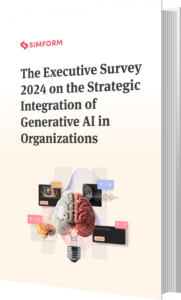PexAI: Ship faster and safer with AI-powered product engineering
Simform’s proprietary framework that codifies product engineering into a repeatable system. It unites our eight engineering objectives with CodeTools automation, proven blueprints, and delivery practices - giving teams a consistent way to modernize, scale, and deliver at speed.
Explore PexAI frameworkEven the most ambitious teams hit the same roadblocks when engineering software products. PexAI is built to address these foundational blockers and accelerate enterprise product engineering.
Immature product function
Tech-powered enterprises invest in platforms but lack product roles, practices, and governance to turn build into business outcomes.
Engineering rework across projects
Without a shared framework, teams solve the same problems repeatedly, leading to inconsistent practices and wasted effort.
Capability gaps across the stack
Many teams lack all-round engineering depth and advanced engineering skills like reliability, platforming, integration, data, AI/ML, and governance.
Rising technical debt at scale
Each new release adds complexity. Without guardrails, architecture and processes accumulate debt that slows down every future change.
How PexAI solves product engineering at scale
PexAI addresses these roadblocks by packaging together pragmatic AI, reusable blueprints, proven frameworks, and Simform’s co-engineering practices into a single, codified system. Each element works as part of a larger whole, ensuring teams move faster, avoid rework, and deliver with confidence.
Pragmatic and Safe AI adoption with CodeTools
AI isn’t layered on as an experiment - it’s built into engineering safely. CodeTools automate boilerplate generation, Infrastructure-as-Code, and even code refactoring, while AI-assisted reviews act as guardrails to catch risks early and ensure responsible adoption.
Reusable Engineering Blueprints
Every product team gains access to engineering blueprints aligned with nine core objectives - modernization, scalable frontends, governance, platforming, and more. These playbooks bring consistency across pods and product lines, eliminating the cycle of solving the same problems from scratch.
Proven frameworks
The system also embeds proven frameworks for reliability, observability, performance, and AI adoption. Rather than relying on ad-hoc methods, teams operate with industry-validated practices built into their workflows, which lowers the risk of downtime, compliance gaps, or scalability bottlenecks.
Co-engineering practices
PEX.AI integrates Simform’s co-engineering methods: knowledge transfer, role development, domain & engineering knowledge management, and Core-Flexi pods. This ensures that capability gaps are closed while aligning engineering moves tightly to business outcomes.
Information Security & IP Assurance
All our accelerators including CodeTools and blueprints are delivered with enterprise-grade safeguards. PexAI ensures data security, IP protection, and compliance with organizational policies, removing hesitation about adopting shared assets into mission-critical environments.
Benefits of PexAI
By adopting PexAI, engineering leaders can expect measurable gains across three dimensions:
Ship faster and safer
PexAI bakes automation, observability, and shift-left QA into every workflow so teams move from discovery to delivery without manual steps. GenAI-assisted refactoring and standardized pipelines lift release velocity while reducing defects. This makes modernization up to 40% faster and everyday delivery more predictable and compliant.
Realize ROI sooner
By replacing ad-hoc rewrites with reusable blueprints and proven frameworks, PexAI cuts rework and lowers cost-to-serve. Systematic modernization and governance reduce legacy sustenance costs by 30–35%, while faster feature throughput brings value to market earlier and with lower operational risk.
Close capability gaps and raise delivery standards
Simform’s co-engineering model closes skill and process gaps across eight product engineering objectives. Knowledge transfer, role development, and domain & engineering knowledge management make practices stick. So teams onboard faster, align on the same playbook, and deliver consistently across product lines.






